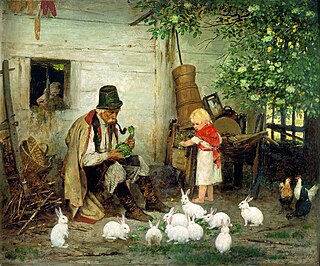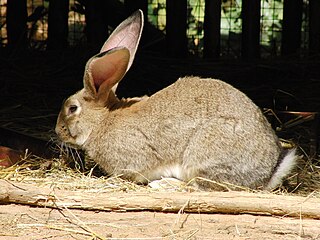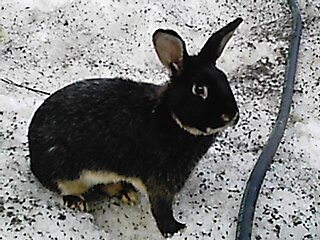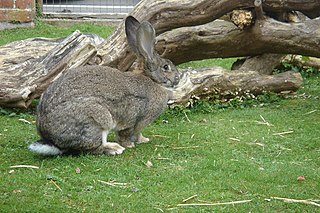
Sint-Niklaas is a Belgian city and municipality located in the Flemish province of East Flanders. The municipality comprises the city of Sint-Niklaas proper and the towns of Belsele, Nieuwkerken-Waas, and Sinaai.

Cuniculture is the agricultural practice of breeding and raising domestic rabbits as livestock for their meat, fur, or wool. Cuniculture is also employed by rabbit fanciers and hobbyists in the development and betterment of rabbit breeds and the exhibition of those efforts. Scientists practice cuniculture in the use and management of rabbits as model organisms in research. Cuniculture has been practiced all over the world since at least the 5th century.

The Angora rabbit, one of the most ancient groups of domestic rabbit breeds, which is bred for the long fibers of its coat, known as Angora wool. They are gathered by shearing, combing or plucking. Because rabbits do not possess the same allergy-causing qualities as many other animals, their wool is an important alternative. There are at least 11 distinct breeds of Angora rabbit, four of which are currently recognized by the American Rabbit Breeders Association (ARBA): the English Angora, the French Angora, the Giant Angora and the Satin Angora. Other unrecognized breeds include the German Angora, the Finnish Angora, the Chinese Angora, the Japanese Angora, the Korean Angora, the Russian Angora, the St Lucian Angora and the Swiss Angora.

Chinchilla rabbits are a group of three rabbit breeds that have been bred for a coat that resembles that of chinchillas. Despite their name, they are not related to, and cannot interbreed with, chinchillas, a genus of rodent. Rabbits, in contrast, are lagomorphs. A mutation diluted the yellow pigment in the hairs to almost white, changing in this way the color of the fur of the wild type fur (agouti) into chinchilla.

The Waasland or Land van Waas is a historic region in northern Belgium. It is part of the Belgian provinces of East Flanders and Antwerp. The other borders are with the Scheldt and Durme rivers and, to the north, the border with the Dutch region of Zeelandic Flanders. The (informal) capital and major city of the region is Sint-Niklaas.

The Flemish Giant rabbit is the largest breed of domestic rabbit. They weigh 6.8 kilograms on average, though the largest ones can weigh up to 22 kilograms. Historically they are a utility breed used for their fur and meat. In the modern day, they are no longer commonly raised for meat, due to their slow growth and very large bones, and are raised for exhibition at rabbit shows. They are often kept as pets as they are known for being docile and patient when being handled.

The American Rabbit is a breed of rabbit, recognized by the American Rabbit Breeders Association (ARBA) in 1917. According to the ARBA Standard of Perfection, American rabbits have a mandolin body shape. It has also been noted for a docile temperament and good mothering abilities. As with all domestic rabbits, the American breed is of the species Oryctolagus cuniculus, the European wild rabbit.
The Beveren is one of the oldest and largest breeds of fur rabbits. It was first bred in Beveren, a small town near Antwerp in Belgium. Their coats can be blue, white, black and lilac, though not all of these varieties are ARBA-recognized. There is a rare variety called the Pointed Beveren, which comes in the same colors but has white tipped hairs. The blue variety is the original.

The Silver Marten is a breed of domestic rabbit. Although they are raised to compete in pet shows and agricultural shows, they are also regarded as "loveable and charming" pets.

The Silver Fox rabbit is a rare breed of domestic rabbit developed by Walter B. Garland of North Canton, Ohio, and bred for meat, show, and its unique fur. The breed is recognized by the American Rabbit Breeders Association.

The New Zealand is a breed of rabbit, which despite the name, is American in origin. The breed originated in California, possibly from rabbits imported from New Zealand. New Zealand rabbits are available in five colors recognized by the American Rabbit Breeders' Association (ARBA): white, red, black, blue, and broken. Crossbreeding can result in many other variations, such as gold tipped steel and chestnut agouti. They average 10–12 lb (4.5–5.4 kg) with the does being slightly larger than the bucks. New Zealands are bred for meat, pelts, show, and laboratory uses, being the most commonly used breed of rabbit both for testing and meat production. They are also bred as pet rabbits but mostly breed for meat.

The Blanc de Hotot is a medium-sized rabbit breed originally developed in France. It is a compact, thickset white rabbit with spectacle-like black rings around each dark eye. First bred in Hotot-en-Auge, Normandy, France in the early 1900s, the breed spread throughout Europe and into North America by the 1920s. Initially unpopular in the United States, it died out there, and suffered population decline in World War II-era Europe. It began to spread again in the 1960s and 1970s, and was re-imported to the US in 1978. Today it is recognized by the British Rabbit Council and the American Rabbit Breeders Association, but is considered globally endangered, with a listing of "threatened" status by the American Livestock Breeds Conservancy.
The Blue of Ham, also known as the Blue of Hem or Bleu de Ham, is a rare breed of domestic rabbit that originated in the Belgian village of Ham-sur-Heure. Developed as a meat and fur breed in 1897 by Ulysses Horemans, the once-popular Blue of Ham became rare following World War II. In 1967, a breeder named Delbusaye recreated the Blue of Ham using the Vienna breed, the Blue of Sint-Niklaas, and the Flemish Giant. Three years later, a standard for the new Blue of Ham was established, and in 1977 the breed was accepted again for exhibition. Today, the Blue of Ham is considered very rare.

The British Giant rabbit is a larger rabbit that has its heritage in the Flemish Giant, a breed that originates in Belgium. The British Giant can grow up to 7 kg and often rivals a small dog in size.

The Fee de Marbourg is a breed of rabbit that originated in Germany where it became known as the Fee de Marbourg, literally "Fairy from Marbourg." The British Rabbit Council recognizes this breed as the Marburger Fee and in the UK it is sometimes referred to as the Marburger.

The Himalayan rabbit is a small breed of rabbit with similar markings to the Californian rabbit. The body is white with colored points, recognized colors are black, blue, chocolate and lilac.

Dwarf Hotot is a breed of domestic rabbit characterized by an entirely white coat, except for a circle of another color around each eye.

The Silver rabbit is a rare breed of domestic rabbit believed to be brought to England by Sir Walter Raleigh in 1592. The breed has been bred for meat, show, and its pelt ever since and is recognized by the American Rabbit Breeders Association (ARBA).
The Blue Imperial rabbit was an English breed of domestic rabbit that is now extinct. It was originally bred by Miss Mabel Illingworth (1879-1955), who was the first woman to create a rabbit breed. It was used to create several modern breeds, including the American rabbit.
















